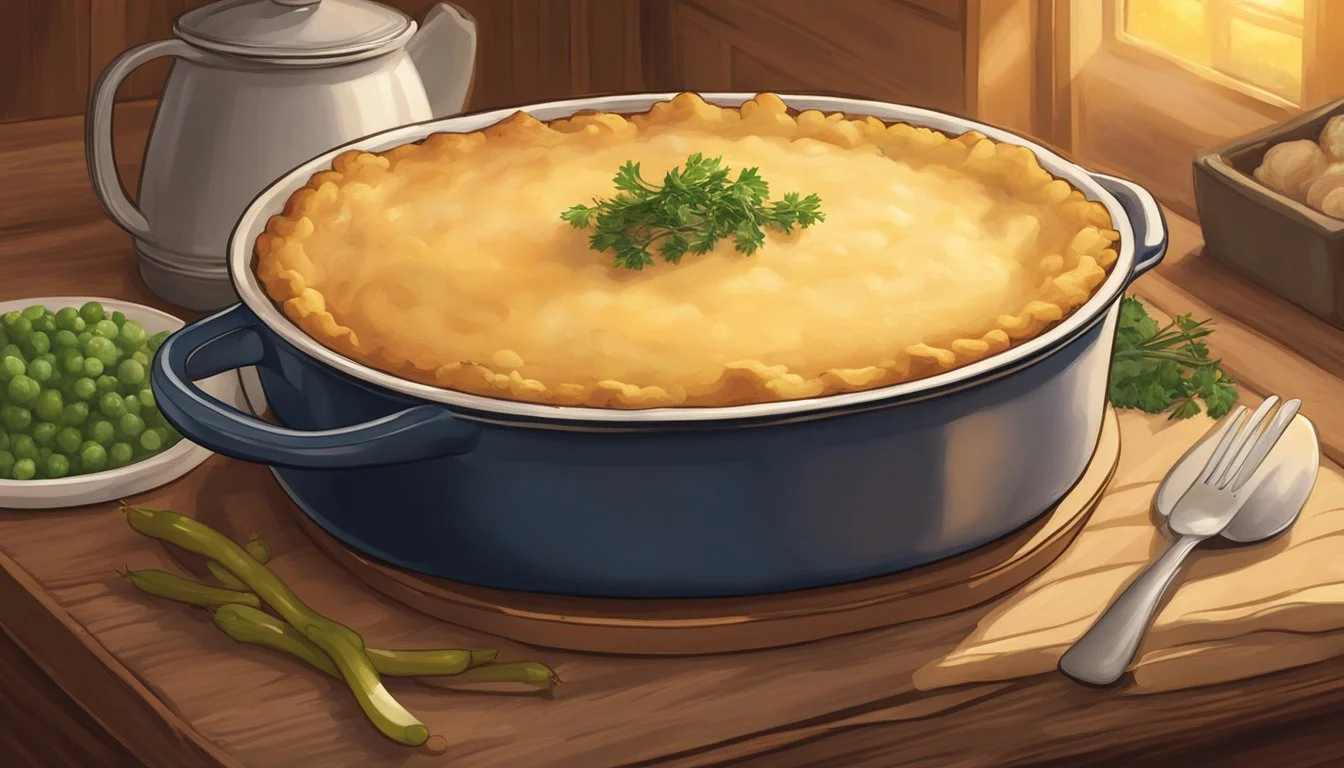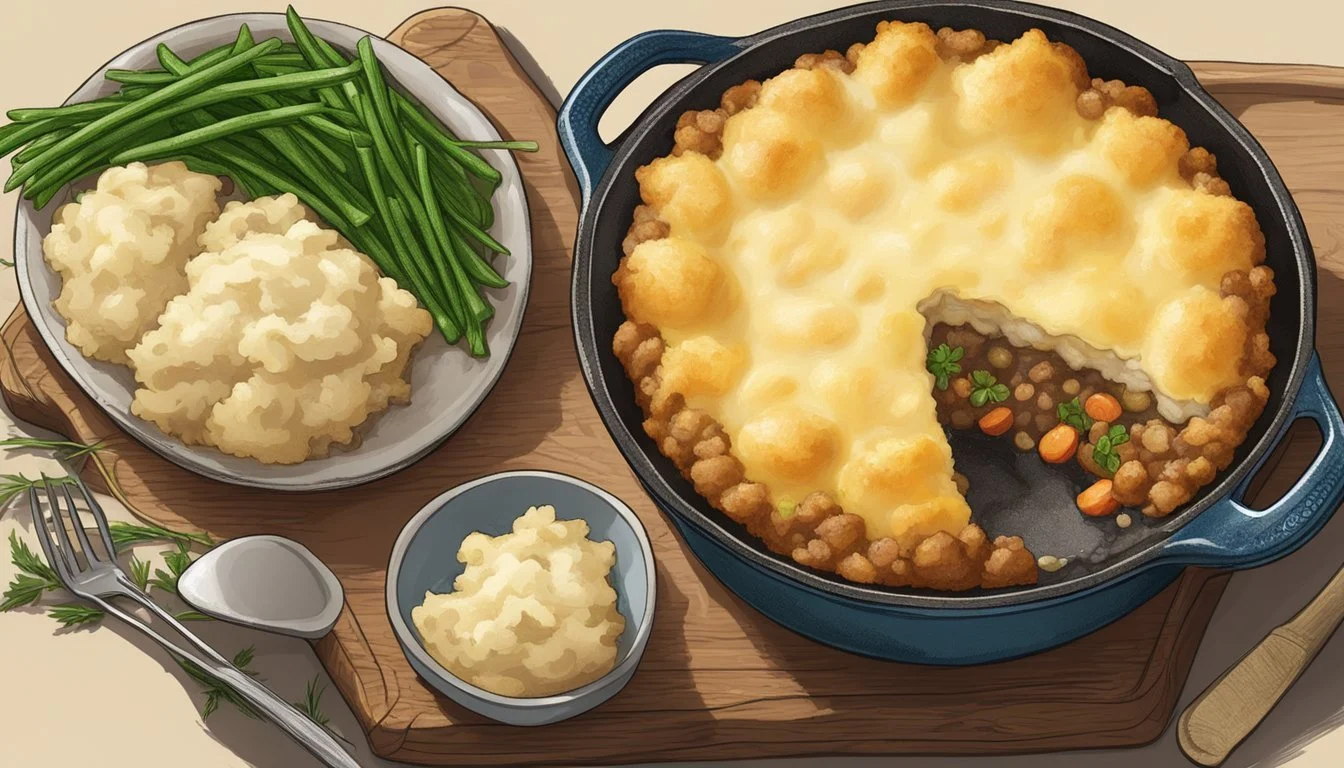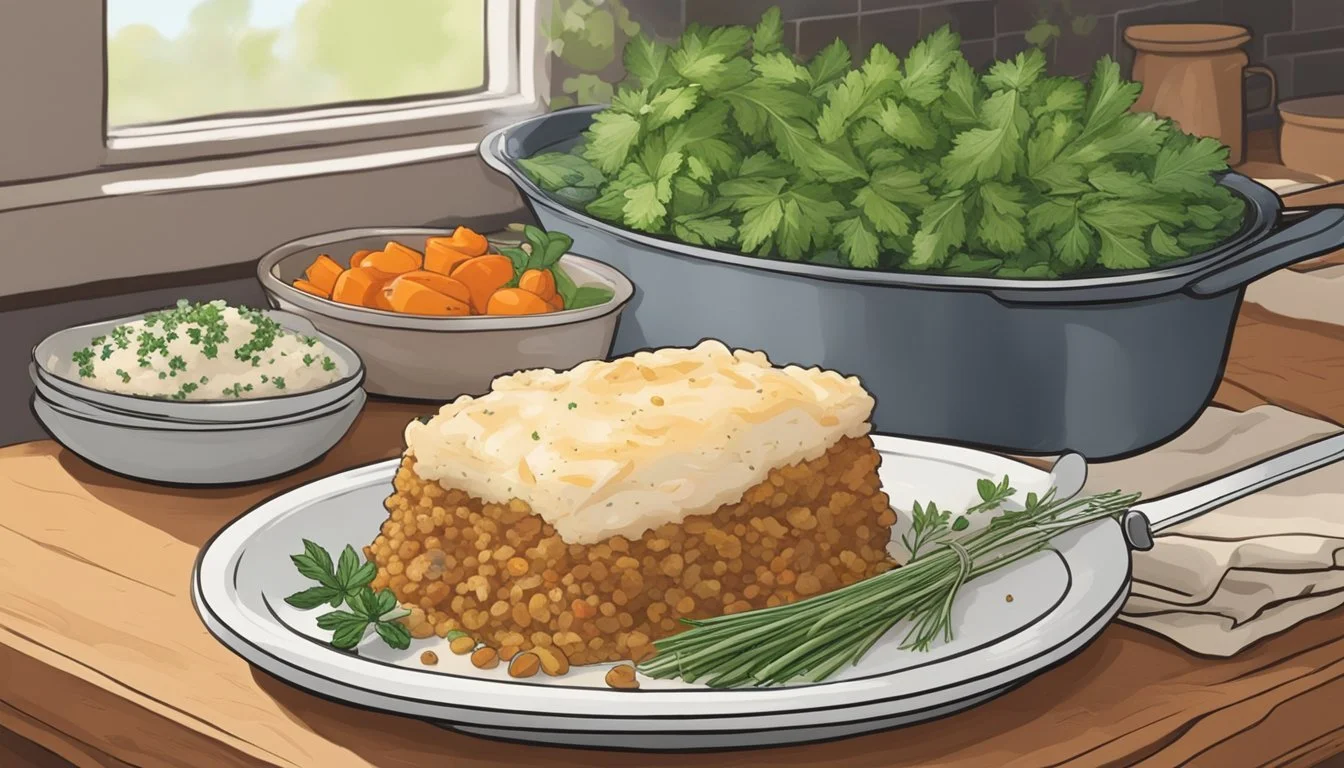Best Way to Reheat Turkey Shepherd's Pie While Preserving Its Flavor and Texture
Turkey Shepherd's Pie is a quintessential comfort food, epitomizing a hearty and satisfying meal that's particularly enjoyable during colder seasons or as a means to use leftover turkey. While savoring it fresh out of the oven is ideal, the reality of leftovers requires a reheating method that preserves its comforting taste and texture. The key is to reheat the pie without drying out the succulent layers of turkey, vegetables, and creamy mashed potatoes.
Reheating this dish involves a careful balance to ensure the pie's interior is warmed through while maintaining the desirable crispy top layer. The oven is often favored for its consistent heat distribution, which is essential for reheating layered dishes like Shepherd's Pie. By covering the pie with aluminum foil, moisture is retained, and the warmth is evenly spread throughout the pie without compromising on flavor or causing sogginess.
The process must be gentle enough to keep the flavors intact but also efficient to return the dish to its original glory. Optimal reheating techniques enable the blend of turkey, vegetables, and potatoes to coalesce into a homely bite that rivals the initial serving. Ensuring that the Shepherd's Pie reaches the appropriate internal temperature is crucial for both taste and food safety, allowing one to relish the pie as if it were freshly made.
Understanding Shepherd's Pie
Shepherd's Pie, a timeless comfort dish, entices diners with its savory layers of meat and vegetables, all crowned with a golden crust of mashed potatoes.
Origins and Variations
The dish known today as Shepherd's Pie originated in the United Kingdom. Traditionally, it refers to a casserole made with ground lamb—hence the name, connecting the shepherd to their flock. A similar preparation made with ground beef is often called Cottage Pie. Both versions emerged in the late 18th century as frugal ways for rural families to repurpose leftover roasted meat.
Through the years, variations have appeared across the globe. The constant features tend to be a meat base often mixed with a gravy or sauce, a medley of vegetables like carrots, peas, and onions, and a topping of mashed potatoes. Some variations even include a layer of melted cheese over the top for added richness.
Key Components
Shepherd's Pie consists of three fundamental layers:
The Meat Layer: The base layer often includes ground lamb in traditional Shepherd's Pie, while ground beef is the meat of choice for Cottage Pie. The meat is cooked with onions, and sometimes garlic, and seasoned with herbs.
The Vegetable Layer: Commonly a mixture of diced carrots, peas, and corn, the vegetables may be mixed in with the meat or layered separately.
The Potato Topping: Creamy mashed potatoes make a comforting top layer. For many, adding a bit of cheese to this layer gives a desirable golden crust post-baking.
This simple yet hearty dish continues to be a beloved meal, offering a canvas for cooks to imprint regional flavors and personal tastes while maintaining its essence as a homely, satisfying casserole.
Preparation Before Reheating
Proper preparation of leftover turkey and Shepherd's pie is crucial for maintaining their quality. The procedures detailed below ensure that the reheating process results in a dish that's as close as possible to its original state.
Storing Leftovers
Turkey:
After the meal, any remaining turkey should be stored efficiently to preserve its flavor and moisture. One should:
Cool the turkey to room temperature.
Slice the turkey into smaller pieces to ensure uniform cooling.
Wrap the pieces tightly in plastic wrap or aluminum foil.
Place the wrapped turkey in an airtight container to protect from freezer burn if freezing.
Store in the refrigerator if it's to be eaten within a few days, or in the freezer for a longer period.
Shepherd's Pie:
For Shepherd's pie leftovers, similar diligence is needed:
Allow the pie to cool to room temperature to prevent condensation inside the storage container.
Cover the dish with a layer of aluminum foil or place it in an airtight container.
If using a container, ensure it's sealed properly to maintain freshness.
Refrigerate if it will be consumed within the next few days.
Thawing and Defrosting
Turkey:
When thawing frozen turkey:
Transfer the turkey from the freezer to the refrigerator.
Allow it to thaw gradually for several hours or overnight, depending on the size of the portions.
Avoid thawing at room temperature to prevent bacterial growth.
Shepherd's Pie:
For Shepherd's pie, the process is simpler:
Take the pie from the freezer and place it in the refrigerator.
Leave it to defrost for several hours until it is completely thawed.
If pressed for time, one can thaw it in the microwave, but do so carefully to avoid cooking any part of it.
Utilizing these methods will ensure turkey and Shepherd's pie are properly prepared for a reheating process that retains their desirable qualities.
Reheating Methods Overview
When reheating Turkey Shepherd's Pie, maintaining its texture and flavor is crucial. The best method depends on the equipment available and how much time one is willing to spend.
Oven Reheating
One can reheat Turkey Shepherd's Pie in the oven to preserve its crisp crust and moist interior. Temperature: Preheat the oven to 350°F (175°C). Method: Cover the pie with foil and heat for 20-30 minutes or until thoroughly warm.
Microwave Reheating
The microwave offers a quick alternative but may not retain the pie's original texture as well as other methods. Temperature: Use a medium setting to prevent overcooking. Method: Place the pie in a microwave-safe container, cover with a lid or a microwave-safe cover, and reheat in intervals, stirring if necessary, until heated through.
Stovetop Reheating
Reheating the Turkey Shepherd's Pie in a skillet can help recreate a crispy bottom. Method: Transfer the pie into the skillet, cover, and reheat over a medium flame until the pie reaches the desired temperature.
Air Fryer Reheating
An air fryer can be used to reheat individual servings while keeping the pie's surface crisp. Temperature: Set the air fryer to 350°F (175°C). Method: Place a portion of the pie in the air fryer basket and heat for a few minutes until it's thoroughly warmed.
Oven Reheating Technique
Reheating turkey Shepherd's pie in the oven is a reliable method to maintain its moisture while restoring its hearty taste and crispy texture. The key is to control the temperature and cover the dish properly to ensure even reheating without drying out the filling or losing the crust's crispiness.
Preheating the Oven
It's essential to begin by preheating the oven. This step ensures that the turkey Shepherd's pie is reheated evenly and quickly, retaining its original flavor and texture. The oven should be set to a moderate temperature to warm the pie without causing the edges to harden or the top to burn.
Preheat the oven to 350 degrees Fahrenheit (177 degrees Celsius).
Covering with Foil
Covering the Shepherd's pie with foil is crucial in preventing moisture loss. Foil acts as a barrier that locks in steam, keeping the turkey and vegetable filling juicy and ensuring that the mashed potato topping remains moist on the inside while regaining its crispiness on the top.
Place the Shepherd's pie in an oven-safe container.
Cover the dish with a layer of aluminum foil, crimping the edges to create an airtight seal.
Reheat until the internal temperature reaches 165 degrees Fahrenheit, which typically takes about 30 minutes depending on the pie's size. Use a meat thermometer to check for doneness.
By following these steps, the turkey Shepherd's pie can be reheated to perfection with its satisfying texture and comforting taste intact.
Microwave Reheating Tips
When reheating Turkey Shepherd's Pie in the microwave, one must focus on preserving the pie's moisture and ensuring even heat distribution to maintain its texture and flavor.
Protecting Moisture
To prevent Turkey Shepherd's Pie from drying out, it's essential to lock in moisture. One should cover the pie with a microwave-safe lid or plastic wrap before heating. This acts as a barrier, retaining steam and preventing dehydration. For added moisture, they can sprinkle a few tablespoons of water or broth over the pie before covering it. Here's a quick guide:
Covering Material: Microwave-safe plastic wrap or lid
Additional Moisture: Water or broth (1-2 tablespoons)
Even Heating
Achieving uniform heating in a microwave can be a challenge due to the appliance's tendency to heat unevenly. They should initially set the microwave to medium heat and stir the pie at regular intervals. This ensures that all parts of the shepherd's pie reach the desired temperature. For best results, one should:
Use medium power for 3-5 minutes.
Stir the pie halfway through the reheating process.
Check the internal temperature to ensure it reaches 165°F (74°C).
Step Action Duration Temperature Check Initial Heating Medium Power 3 Min -- Stirring for Evenness Stir Gently -- -- Additional Heating Medium Power Up to 2 Min 165°F (74°C) Required
By following these techniques, one ensures an evenly heated Turkey Shepherd's Pie with a preserved hearty and comforting taste.
Enhancing Flavor and Texture
When reheating Turkey Shepherd's Pie, maintaining its hearty and comforting taste is pivotal. The focus should be on reintroducing moisture and enhancing the savory elements that could have diminished during storage.
Adding Fresh Ingredients
Incorporating fresh ingredients is an impactful way to breathe life back into Thanksgiving leftovers. Diced onions sautéed until translucent can add a fresh aromatic base, while stirring in freshly steamed carrots and crisp, bright green peas can uplift the pie’s texture and infuse vibrancy.
Veggies:
Sauté onions before adding.
Steam carrots and peas; fold into the mixture.
Adjusting Seasonings
Turkey Shepherd's Pie may lose some of its flavors after refrigeration. A confident cook knows seasoning adjustments are essential. Generous pinches of salt and pepper can restore lost tastes, while a touch of butter melted into the mixture can enhance richness. Sprinkling freshly grated cheese on top before reheating not only enriches flavor but also improves texture with a bubbly, golden crust.
Seasonings (Add before reheating):
Salt: Pinch or to taste
Pepper: Freshly ground to taste
Butter: Melt a tablespoon
Texture Enhancers (Add before the final few minutes of reheating):
Cheese: Grated (Cheddar or a similar variety)
Alternative Reheating Options
When reheating Turkey Shepherd's Pie, one might consider alternatives to the traditional oven for convenience or speed. These methods can effectively warm the pie while maintaining its texture and flavor.
Skillet Reheating
Using a skillet for reheating can provide a crisped base and evenly heated filling. For optimal results, one should:
Heat a skillet on the stovetop over medium heat.
Add Shepherd's Pie: Transfer a serving to the skillet.
Cover the skillet with a lid to allow the heat to circulate and the filling to warm thoroughly.
Cook for a few minutes: Monitor the dish to prevent scorching, stirring occasionally if necessary.
Toaster Oven Reheating
A toaster oven offers a smaller space that can heat quickly and is ideal for single servings. It mirrors the dry heat method of a traditional oven on a more compact scale. To reheat in a toaster oven:
Preheat the toaster oven to about 350 degrees Fahrenheit.
Place the pie in an oven-safe dish that fits comfortably within the toaster oven.
Cover with foil: Shielding with foil prevents the top from burning while the rest of the pie heats up.
Bake until heated through: Typically, this takes less time than in a regular oven due to the smaller space and closer heating elements.
These alternative reheating methods, while not traditionally recommended for other pastry-centric dishes like quesadillas, empanadas, or chicken pot pie, can be adjusted slightly for Turkey Shepherd's Pie to retain its hearty essence without compromising its comforting flavors.
Safety and Quality Considerations
When reheating a turkey shepherd's pie, maintaining food safety and quality is paramount. The pie must reach an internal temperature of 165°F (74°C) to ensure it is safe to consume, especially important when dealing with leftovers. Use a food thermometer to check this temperature in the pie's center.
Quality is also crucial for enjoying the hearty and comforting taste of the dish. Shepherd's pie should retain its moist filling and crisp topping. To achieve this, one should reheat the pie gradually and evenly.
For frozen shepherd's pie, it is recommended to thaw the pie in the refrigerator before reheating. Sudden temperature changes can affect both texture and flavor.
Here are some reheating methods with considerations for safety and quality:
Oven:
Preheat to 350°F (175°C).
Place the pie in an oven-safe dish.
Cover with foil for even heating and moisture retention.
Microwave:
Use a microwave-safe container.
Heat in short intervals, stirring if needed, to avoid cold spots.
Remember, reheating methods could vary based on whether the shepherd's pie is being reheated from refrigerated or frozen states.
Regarding dessert shepherd's pies, which may contain fruits or sweet ingredients, reheating requires a more delicate approach to preserve the dessert’s integrity and avoid overcooking.
Always store leftovers promptly within 2 hours of cooking and consume reheated shepherd's pie within three to four days for ideal quality and safety.
Serving and Accompaniments
Reheated turkey shepherd's pie can retain its hearty essence with proper serving and thoughtfully chosen accompaniments. This part of the meal brings contrast or complements the pie's rich flavors.
Presentation Tips
When serving a turkey shepherd's pie, one should ensure the dish is visually appealing to enhance the dining experience. Serving it directly from the oven can maintain its crispy topping, which is a key element of its texture. To serve, use a scoop or large spoon to present well-defined portions, maintaining the structure of the layers.
Side Dishes and Pairings
A balanced meal includes side dishes that complement the main course both in flavor and nutrition. For turkey shepherd's pie, simple side salads dressed in a light vinaigrette can offer a refreshing contrast. Likewise, steamed or roasted vegetables such as peas, carrots, and celery harmonize with the pie's savory taste. If one desires to adhere to traditional roots, a side of vegetables prepared in a bit of tomato paste and chicken broth can enrich the meal with comforting flavors.
Conclusion
Reheating a turkey shepherd's pie requires attention to detail to preserve its heartwarming deliciousness. The key lies in gentle reheating, which ensures that the flavors meld together as if freshly cooked. For those handling Thanksgiving leftovers, a well-executed reheating process can revitalize the dish, making it just as inviting the day after.
Here are some succinct tips:
Temperature: Reheat at 350°F (177°C), a moderate temperature that heats without drying out the meal.
Covering: Wrap the dish in aluminum foil to retain moisture and prevent the top from burning.
Timing: Allow 30-40 minutes for reheating, checking the middle is hot. For frozen pie, doubling the time is a good rule of thumb.
One final reminder for the perfect outcome: if a crispy crust is desired, remove the foil in the final 10 minutes. By following these guidelines, the integrity of the shepherd's pie is maintained, both in taste and texture. This turns Thanksgiving turkey leftovers into an encore presentation that might just rival the holiday meal itself.







